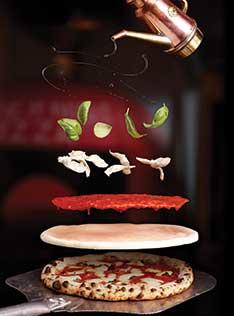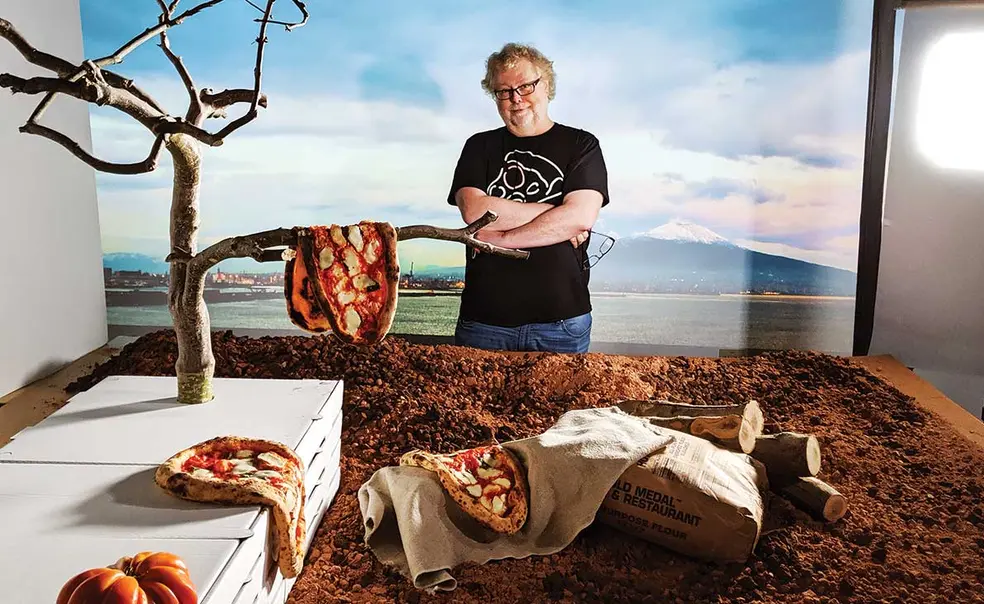Nathan Myhrvold *83 Wrote 1,708 Pages About Pizza
‘I’d encourage everyone to step a little outside their comfort zone,’ says Myhrvold
Nathan Myhrvold *83 has eaten a lot of pizzas and has a lot of thoughts about them. How many thoughts? Enough to fill 1,708 pages of his latest book, Modernist Pizza.
A true polymath, Myhrvold has a range of interests and talents that might be called omnivorous. For 13 years Princeton’s 2005 Madison medalist served as chief technology officer for Microsoft, founded its subsidiary Microsoft Research, and later co-founded Intellectual Ventures, which buys patents in emerging technologies. Whatever he does, he likes to do big. He has won awards as a wildlife photographer and has an authentic 45-foot-long T. rex skeleton in his living room.
So, it is not surprising that Myhrvold’s interest in food is also ravenous. While working at Microsoft, he earned a degree from the École de Cuisine La Varenne in France, and he has apprenticed at a top Seattle restaurant and been part of an award-winning team at the world barbecue championships in Memphis, Tennessee. For Modernist Pizza, Myhrvold and his co-author, chef Francisco Migoya, visited more than 250 pizzerias around the world, sampling thin crusts, deep dishes, and everything in between.
The book includes three volumes and a kitchen manual, covering the history and fundamentals of pizza, techniques and ingredients, and more than 1,000 recipes. The volumes are lavishly illustrated with 3,700 photos; boxed in a stainless-steel case, the set weighs in at a hefty 35.5 pounds. That still makes it shorter and lighter than two of Myhrvold’s previous books, Modernist Cuisine (2,438 pages and 52 pounds) and Modernist Bread (2,642 pages and 50 pounds), both of which won the James Beard Cookbook Award. (The next book in the series, he says, will cover pastry.)
Opinions about pizza, however, tend to be more visceral than academic, so PAW senior writer Mark F. Bernstein ’83 spoke with Myhrvold to settle some debates.
You have said that the first pizza you ever ate was from Shakey’s, so I suppose you had nowhere to go but up.
(Laughs.) It turns out that as infants and as children, we don’t always have our best food experiences. Gerber’s strained peas are not my favorite kind of peas anymore, for example.
Yes, I’ve certainly had a lot better pizza than Shakey’s, but Shakey’s plays a role in the history of pizza. It opened in 1954, so it was the first fast-food chain in the country — of any kind of food. Which is kind of remarkable considering that there are plenty of things that you’d think of as more American, like hamburgers or fried chicken, but America had adopted the pizza pretty thoroughly by that point.
There are a lot of national pizza chains today. Are any of them any good?
Well, you have to remember that they’re offering two things besides just pizza: price and convenience. Some of the chains have these ads on TV where you can get a pizza for $5. Good luck getting a deal like that anywhere else. And chains are also convenient because they get it to you super fast.
Those values are important to people, so they have their role. In general, I think you’d find it better to have a pizza from one of the national chains than to have a frozen pizza, although frozen pizzas also have their role in the grand scheme of things. The pizzas that are going to taste the best are the ones that are made by someone who uses high-quality ingredients and has an enormous amount of skill, and they’re probably going to cost more than $5. But if I said those are the only worthy pizzas, I would be ignoring the fact that millions of people today get one of those takeout pizzas delivered with very high convenience and good cost.
There are several regional styles of pizza in the United States. How did they come about, and do you have a preference among them?
For some reason, people decided that pizza was a food to be experimented with, and they did. You could have a super-thin crust and a super-thin topping; that’s what they do in São Paolo. Or you could say, I’ll make the crust really thick and sprinkle cheese around the edges — and that’s a Detroit-style pizza. Pretty much every dial you can twist, people have twisted.
In Chicago, which is known for deep-dish pizza, the legend is that people who wanted to create a competitor to Pizzeria Uno staked out the garbage cans behind the restaurant, waiting for the head chef to come out so they could talk to her and try to hire her away. A little-known aspect of that story is that all of the pizzaiolos at Pizzeria Uno during their formative years were African American women. And they were all related to each other.
What’s your favorite type of pizza?
Usually, I go for a fairly simple pizza these days. If it’s a New York style, I’d go for pepperoni. If it was a more artisanal, I’d go for margherita. Still, I’d encourage everyone to step a little outside their comfort zone because, particularly at the right place, it can be incredibly good.

If I have only a pizza stone and a gas oven at home, can I still make a good pizza?
Absolutely! If you wanted to make a traditional Neapolitan-style pizza, I’d say OK, but that’s going to take some experimentation. But if you’re willing to make a New York-style pizza, a pizza stone and an oven should be just fine. In general, thicker crust pizzas work better at home because a thicker crust is a little more forgiving. It doesn’t burn as easily.
What are some easy things people can do to make a better pizza?
The first thing is to practice. Home chefs are way too hard on themselves. They try a complicated recipe once and if it doesn’t turn out perfectly, they say, “Oh, I screwed up. It’s not as good as the restaurant.” And if I’m there I’ll say, “Do you really think this is the first time the restaurant made that dish?”
The thing most people find intimidating about pizza-making is the dough. But plenty of people who make pizza at home begin with a prebaked crust, which you can buy in most grocery stories, and that’s fine, that’s a good place to start. Don’t be afraid of the crust, though; it’s not that hard to make. And usually, even if what you get isn’t pretty, if all you end up with is a lot of melted cheese and fresh hot bread — how bad is it going to be?
So, I don’t have to know how to toss the pizza dough like they do in the movies?
Flipping the dough is entirely showmanship. No professional flips the dough and claims it’s actually part of making a better pizza. In fact, it’s almost always part of making a worse pizza because there’s a chance you don’t catch it.
Please settle this once and for all: Is pineapple an acceptable topping on pizza?
The so-called Hawaiian pizza with Canadian bacon and pineapple was actually invented in Toronto. I don’t blame the guy for trying to make something that seemed sunny and far away because in January in Toronto it’s pretty cold. There are people who love it and people who hate it [the pizza]. In Buenos Aires, they put rings of pineapple down and fill the centers with green olives. That’s an even less likely combination, in my opinion.
Any thoughts about eating cold leftover pizza for breakfast?
We have a whole section on this in the book, because what do you do with leftover pizza? One approach is to revel in the leftover pizza and eat it cold. The more you like that, the closer you are to having lived in a dorm.
But we also explain how to reheat pizza. Different types of pizza reheat differently. Perhaps the hardest to reheat are the super-thin crust Neapolitan pizzas, so we invented something we call the pizzadilla. You take some extra cheese, throw it on your couple of slices of pizza, fold them over, and then cook it in a pan like a quesadilla. It’s excellent! Now, it’s not pizza at that point but it’s a lot better than eating it cold, in my view.
Finally, is it ever acceptable to eat pizza with a knife and fork?
As we’ve established, my pizza career started at Shakey’s, so I think pizza should be eaten with my hands. Now, in Europe they eat it with a knife and fork. If I’m eating pizza in a restaurant in Europe I always feel like, oh God, I’m the uncouth American animal for eating it with my hands. But usually after struggling through a few slices with a knife and fork, I just pick it up.
Interview conducted and condensed by Mark F. Bernstein ’83












No responses yet